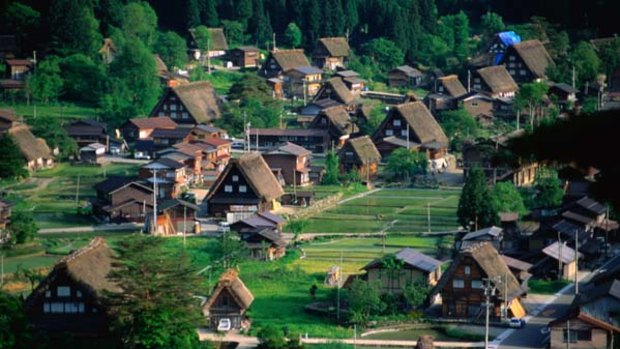
Older and colder ... Shirakawa-go village.Credit: Martin Moos/Lonely Planet
It takes a special person to live in a frigid, historic 'gassho' house. A shivering Julie Miller can only agree.
Some things go out of style for a reason. In the case of the "gassho" houses of central Japan, practicality has mostly won out over tradition - and even those who live in the few remaining examples aren't surprised.
"It takes a special person to live in a gassho house," we are told as we sit shivering around a roaring but seemingly useless fire inside one of the massive, thatched, five-storey houses scattered throughout Shirakawa-go, a village in Gifu prefecture. "The cold makes you stronger."
Considering my feet are frozen, ears numb and my breath a smokestack, I am dubious about the strength-giving qualities of such extreme conditions. The resident, however, is speaking with genuine pride - he considers it an honour to dwell in this historic museum house, despite the cost on health and pocket.
One can only wonder why these 400-year-old houses were built in the first place. "Gassho-style houses have three enemies," we are told. "Dilapidation, fire and snow." All three seem unavoidable hazards here in the mountains; they are buried under three-metre snow drifts for at least six months of the year; they require an indoor fire 24-7 for heating; while age, weather and the sheer scale of the buildings demand constant maintenance.
With about 114 examples of these amazing structures still standing, Shirakawa-go is a time capsule recognised by UNESCO, which granted the town World Heritage listing in 1995. Today, it is popular with tourists who come to admire the quaint, pretty setting and wander through several buildings open to the public to learn about traditions of the past.
"Gassho" is the Japanese word for prayer and the buildings were so named because the roofs resemble hands pressed together in worship. The sheer size of the thatched slopes is difficult to comprehend - though archival photos showing at least 60 villagers working together over four consecutive days to re-thatch during spring give some perspective of the massive undertaking.
Our visit, however, coincides with deepest winter; the roofs are encrusted with a metre of snow, sculptural drifts burying entranceways up to first-storey windows. In keeping with Japanese tradition, we replace our boots with indoor slippers as we enter the Myozenji Museum, an artefacts museum and living quarters for staff from the adjoining temple. Immediately, my toes turn to ice; despite a fire constantly sending heat through the slatted floors, the energy transfer is astoundingly inefficient, with temperatures at least 5 degrees colder than outside.
As well as allegedly "heating" the houses, the massive fireplace serves another purpose: the smoke blackens the wood and makes the thatch more durable. What it has done to the lungs of residents over the years is questionable, of course.
Needless to say, Shirakawa-go is on constant fire alert - signs outside houses warn tourists not to smoke nearby (though curiously, a gassho-style restaurant still allows smoking indoors, with Japan one of the last bastions of frantic puffers).
Despite the bitter cold, a tour through one of these cavernous, multistorey buildings is an eye-opener to life in another age - not one nail has been used, with beams tied together with rope made from twisted witch hazel, while the upper level of each house was traditionally used to raise silkworms, an industry that once supported the lives of Shirakawa-go residents.
Continuing along a walkway, the museum leads to the town's temple, though the thought of worshipping in such frigid conditions sends us scurrying back to the relative warmth of the fire.
Huddled around the smoking pit, one of our group asks if it's possible for her "temple book" - a book carried by pilgrims as evidence of the temples they have visited - to be stamped. Our new friend obligingly wanders off to find the resident priest, who returns 15 minutes later bearing the most beautiful, intricate work of art, a lovingly hand-painted image of a "gassho" house decorated with calligraphy as well as the obligatory stamp.
Such is the pride of the people of Shirakawa-go. I guess what doesn't kill you really does make you stronger.
The writer was a guest of Ishikawa and Gifu prefectures and Japan National Tourism Organisation.
TRIP NOTES
GETTING THERE
Shirakawa-go is in Gifu prefecture, in central Honshu. The closest large city is Kanazawa in Ishikawa prefecture. Qantas flies daily from Sydney to Tokyo, with domestic transfers to Kanazawa with JAL. See qantas.com.au and jal.com.
To get to Shirakawa-go, take a bus from in front of Kanazawa station. The journey takes 75 minutes and there are three buses a day.
WHILE THERE
Pick up a map of Shirakawa-go at the visitor information centre on the main road.
Entry into the Myozenji Museum and Temple and other houses open to the public costs ¥300 for an adult (about $3.40).
WHERE TO STAY
The Kanazawa Sky Hotel offers modern business-style accommodation in the heart of Kanazawa city. Priced from about $100 a night. See skyhotel.co.jp.
FURTHER INFORMATION
See shirakawa-go.org and jnto.org.au.
Sign up for the Traveller Deals newsletter
Get exclusive travel deals delivered straight to your inbox. Sign up now.